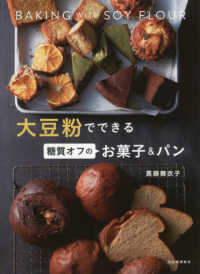- ホーム
- > 洋書
- > 英文書
- > Science / Mathematics
Full Description
Completely revised and updated, the second edition of the Handbook of Superconductivity is now available in three stand-alone volumes. As a whole they cover the depth and breadth of the field, drawing on an international pool of respected academics and industrial engineers. The three volumes provide hands-on guidance to the manufacturing and processing technologies associated with superconducting materials and devices. A comprehensive reference, the handbook supplies a tutorial on techniques for the beginning graduate student and a source of ancillary information for practicing scientists. The past twenty years have seen rapid progress in superconducting materials, which exhibit one of the most remarkable physical states of matter ever to be discovered. Superconductivity brings quantum mechanics to the scale of the everyday world where a single, coherent quantum state may extend over a distance of metres, or even kilometres, depending on the size of a coil or length of superconducting wire. Viable applications of superconductors rely fundamentally on an understanding of this intriguing phenomena and the availability of a range of materials with bespoke properties to meet practical needs. This first volume covers the fundamentals of superconductivity and the various classes of superconducting materials, which sets the context for volumes 2 and 3. Volume 1 ends with a tutorial on phase diagrams, and a glossary relevant to all 3 volumes.
Contents
Foreword. Preface. Acknowledgements. Editors-in-Chief. Contributors. Volume 1 - Fundamentals and Materials. Part A Fundamentals of Superconductivity. A1 Introduction to Section A1: History, Mechanisms and Materials. A1.1 Historical Development of Superconductivity. A1.2 An Introduction to Superconductivity. A1.3 The Polaronic Basis for High-Temperature Superconductivity. A2 Introduction to Section A2: Fundamental Properties. A2.1 Phenomenological Theories. A2.2 Microscopic Theory. A2.3 Normal-State Metallic Behavior in Contrast to Superconductivity: An Introduction. A2.4 The Meissner-Ochsenfeld Effect. A2.5 Loss of Superconductivity in Magnetic Fields. A2.6 High-Frequency Electromagnetic Properties. A2.7 Flux Quantization. A2.8 Josephson Effects. A2.9 Other Josephson-Related Phenomena. A3 Introduction to Section A3: Critical Currents of Type II Superconductors. A3.1 Vortices and Their Interaction. A3.2 Flux Pinning. Part B Low-Temperature Superconductors. B Introduction to Section B: Low-Temperature Superconductors. B1 Nb-Based Superconductors. B2 Magnesium Diboride. B3 Chevrel Phases. Part C High-Temperature Superconductors. C Introduction to Section C: High-Temperature Superconductors. C1 YBCO. C2 Bismuth-Based Superconductors. C3 TIBCCO. C4 HgBCCO. C5 Iron-Based Superconductors. C6 Hydrides. Part D Other Superconductors. D Introduction to Section D: Other Superconductors. D1 Unconventional Superconductivity in Heavy Fermion and Ruthenate Materials. D2 Organic Superconductors. D3 Fullerene Superconductors. D4 Future High-Tc Superconductors. D5 Fe-Based Chalcogenide Superconductors. D6 Interface Superconductivity. D7 Topological Superconductivity. Volume 2 - Processing and Cryogenics. PART E Processing. E1 Introduction to Processing Methods. E2 Introduction to Section E2: Bulk Materials. E2.1 Introduction to Bulk Firing Techniques. E2.2 (RE)BCO Melt Processing Techniques: Fundamentals of the Melt Process. E2.3 Melt Processing Techniques: Melt Processing for BSCCO. E2.4 Growth of Superconducting Single Crystals. E2.5 Growth of A15 Type Single Crystals and Polycrystals and Their Physical Properties. E2.6 Irradiation. E2.7 Superconductors in Future Accelerators: Irradiation Problems. E3 Introduction to Section E3: Processing of Wires and Tapes. E3.1 Processing of High Tc Conductors: The Compound Bi-2212. E3.2 Processing of High Tc Conductors: The Compound Bi,Pb(2223). E3.3 Highlights on Tl(1223). E3.4 Processing of High Tc Conductors: The Compound YBCO. E3.5 Processing of High Tc Conductors: The Compound Hg(1223). E3.6 Overview of High Field LTS Materials (Without Nb3Sn). E3.7 Processing of Low Tc Conductors: The Alloy Nb-Ti. E3.8 Processing of Low Tc Conductors: The Compound Nb3Sn. E3.9 Processing of Low Tc Conductors: The Compound Nb3Al. E3.10 Processing of Low Tc Conductors: The Compounds PbMo6S8 and SnMo6S8. E3.11 Processing of Low Tc Conductors: The Compound MgB2. E3.12 Processing Pnictide Superconductors. E4 Introduction to Section E4: Thick and Thin Films. E4.1 Substrates and Functional Buffer Layers. E4.2 Physical Vapor Thin-Film Deposition Techniques. E4.3 Chemical Deposition Processes for REBa2Cu3O7 Coated Conductors. E4.4 High Temperature Superconductor Films: Processing Techniques. E4.5 Processing and Manufacture of Josephson Junctions: Low-Tc. E4.6 Processing and Manufacture of Josephson Junctions: High-Tc. E5 Introduction to Section E5: Superconductor Contacts. E5.1 Superconductor to Normal-Metal Contacts. E5.2 Resistive High Current Splices. E5.3 Persistent Mode Joints. PART F Refrigeration Methods. F1 Introduction to Part F: Refrigeration Methods. F1.1 Review of Refrigeration Methods. F1.2 Pulse Tube Cryocoolers. F1.3 Gifford-McMahon Cryocoolers. F1.4 Microcooling. F1.5 Cooling with Liquid Helium. Volume 3 - Characterization and Applications. Part G Characterization and Modelling Techniques. G1 Introduction to Section G1: Structure/Microstructure. G1.1 X-Ray Studies: Chemical Crystallography. G1.2 X-Ray Studies: Phase Transformations and Microstructure Changes. G1.3 Transmission Electron Microscopy. G1.4 An Introduction to Digital Image Analysis of Superconductors. G1.5 Optical Microscopy. G1.6 Neutron Techniques: Flux-Line Lattice. G2 Introduction to Section G2: Measurement and Interpretation of Electromagnetic Properties. G2.1 Electromagnetic Properties of Superconductors. G2.2 Numerical Models of the Electromagnetic Behavior of Superconductors. G2.3 DC Transport Critical Currents. G2.4 Characterisation of the Transport Critical Current Density for Conductor Applications. G2.5 Magnetic Measurements of Critical Current Density, Pinning, and Flux Creep. G2.6 AC Susceptibility. G2.7 AC Losses in Superconducting Materials, Wires, and Tapes. G2.8 Characterization of Superconductor Magnetic Properties in Crossed Magnetic Fields. G2.9 Microwave Impedance. G2.10 Local Probes of Magnetic Field Distribution. G2.11 Some Unusual and Systematic Properties of Hole-Doped Cuprates in the Normal and Superconducting States. G3 Introduction to Section G3: Thermal, Mechanical, and Other Properties. G3.1 Thermal Properties: Specific Heat. G3.2 Thermal Properties: Thermal Conductivity. G3.3 Thermal Properties: Thermal Expansion. G3.4 Mechanical Properties. G3.5 Magneto-Optical Characterization Techniques. Part H Applications. H1 Introduction to Large Scale Applications. H1.1 Electromagnet Fundamentals. H1.2 Superconducting Magnet Design. H1.3 MRI Magnets. H1.4 High-Temperature Superconducting Current Leads. H1.5 Cables. H1.6 AC and DC Power Transmission. H1.7 Fault-Current Limiters. H1.8 Energy Storage. H1.9 Transformers. H1.10 Electrical Machines Using HTS Conductors. H1.11 Electrical Machines Using Bulk HTS. H1.12 Homopolar Motors. H1.13 Magnetic Separation. H1.14 Superconducting Radiofrequency Cavities. H2 Introduction to Section H2: High-Frequency Devices. H2.1 Microwave Resonators and Filters. H2.2 Transmission Lines. H2.3 Antennae. H3 Introduction to Section H3: Josephson Junction Devices. H3.1 Josephson Effects. H3.2 SQUIDs. H3.3 Biomagnetism. H3.4 Nondestructive Evaluation. H3.5 Digital Electronics. H3.6 Superconducting Analog-to-Digital Converters. H3.7 Superconducting Qubits. H4 Introduction to Radiation and Particle Detectors that Use Superconductivity. H4.1 Superconducting Tunnel Junction Radiation Detectors. H4.2 Transition-Edge Sensors. H4.3 Superconducting Materials for Microwave Kinetic Inductance Detectors. H4.4 Metallic Magnetic Calorimeters. H4.5 Optical Detectors and Sensors. H4.6 Low-Noise Superconducting Mixers for the Terahertz Frequency Range. H4.7 Applications: Metrology. Glossary. Index.








